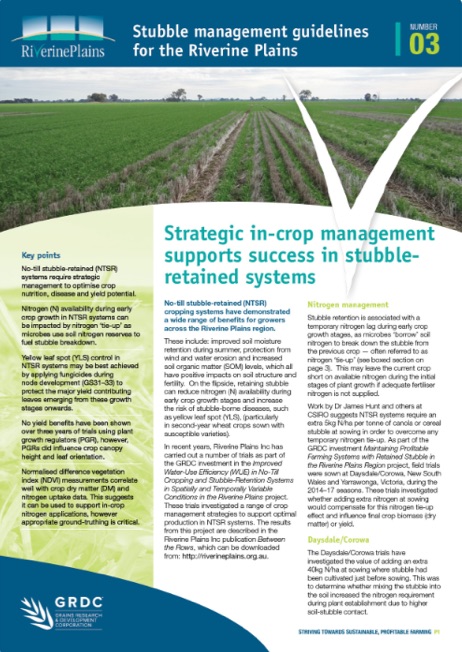Stubble Guideline 3: Strategic in-crop management supports success in stubble retained systems
Practical information to help farmers with their in-crop nitrogen, disease and canopy management decisions when growing crops in stubble retained systems.

Publication date
01 Dec 2018
Publication partner
This publication was supported by the Grains Research and Development Corporation.
LEARN ABOUT MANAGING IN-CROP NITROGEN, DISEASE AND CANOPY MANAGEMENT IN NO-TILL STUBBLE RETAINED SYSTEMS
Guideline #3
While retaining stubble has many benefits, it can also tie up nitrogen early in the early stages of crop development and host serious diseases of wheat, such as yellow leaf spot.
This stubble management guideline describes how yield can be affected by different stubble management techniques in no-till stubble-retained systems (NTSR), while taking into consideration the effect of nitrogen, disease and canopy management.
What we discovered
This guideline outlines several key learnings from the Stubble project, including that:
- NTSR systems require strategic management to optimise crop nutrition, disease and yield potential.
- Nitrogen availability during early crop growth in NTSR systems can be impacted by nitrogen ‘tie-up’ as microbes use soil nitrogen reserves to fuel stubble breakdown.
- Yellow leaf spot (YLS) control in NTSR systems may be best achieved by applying fungicides during node development (GS31–33) to protect the major yield contributing leaves emerging from these growth stages onwards.
- No yield benefits were shown over three years of trials using plant growth regulators (PGR), however, PGRs did influence crop canopy height and leaf orientation.
- Normalised difference vegetation index (NDVI) measurements correlate well with crop dry matter (DM) and nitrogen uptake data. This suggests it can be used to support in-crop nitrogen applications, however appropriate ground-truthing is critical.
Learn more about how to manage nitrogen nutrition, disease and canopy structure in no-till stubble retained systems of the Riverine Plains.
NEWS
Discover unique perspectives on agriculture from across the Riverine Plains.
-
Livestock
-
People
-
Grains
-
Sustainability

